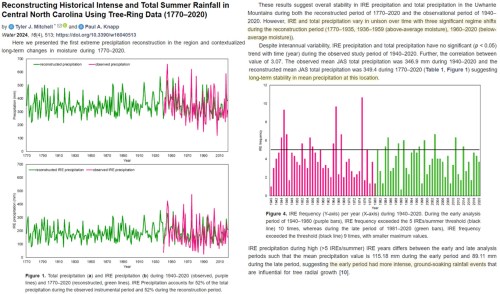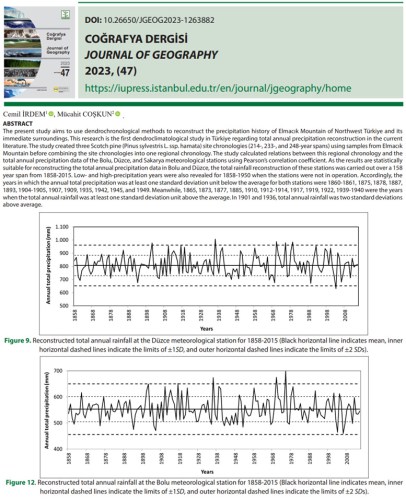 New research (Mitchell and Knapp, 2024) at a southeastern United States study site indicates there has been no significant trend in either total precipitation or intense rainfall events (IRE) over the last 250 years (1770-2020).
New research (Mitchell and Knapp, 2024) at a southeastern United States study site indicates there has been no significant trend in either total precipitation or intense rainfall events (IRE) over the last 250 years (1770-2020).
However, there was more IRE precipitation from 1936-1959 than 1960-2020. [emphasis, links added]
In fact, the most recent 60 years have the lowest record of extreme precipitation during the study, with averages of 81.20 mm for 1770–1935, 230.45 mm for 1936–1959, but just 168.27 mm during 1960–2020.
“Despite interannual variability, IRE [intense rainfall events] precipitation and total precipitation have no significant (p < 0.05) trend with time (year) during the observed study period of 1940–2020.
“Similarly, over the longer-term reconstructed time period (i.e., 1770–2020), the reconstructed values of total precipitation and IRE precipitation have remained stable with no significant correlation with time (year). The total precipitation and IRE precipitation reconstructions have the same significant regime shifts during the reconstruction period (Figure 3): 1770–1935, 1936–1959 (above-average moisture), and 1960–2020 (below-average moisture).
“The mean total precipitation values for each regime are 347.45 mm (1770–1935), 409.70 mm (1936–1959), and 331.11 mm (1960–2020) while the mean IRE precipitation values for each regime are 181.20 mm (1770–1935), 230.45 mm (1936–1959), and 168.27 mm (1960–2020), suggesting that IRE and total precipitation has been mostly stable since 1770 with the exception of the 1936–1959 regime period.”

Another new study (Irdem and Coskun, 2024) found no trend in precipitation in NW Turkey (Türkiye) throughout the 1858-2015 period.

Finally, proxy data from Eastern China suggests no precipitation trend has been detectable in this region since 1896 (Sun et al., 2024).

Read more at No Tricks Zone



















This will change in the new cyclical cold stage/glacial period that the Earth is currently at the beginning of.